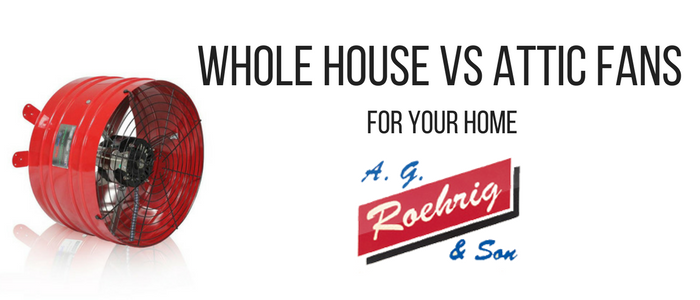
Whole House Fans vs. Attic Fans
Whole house fans are really old technology.
The purpose of a whole house fan was you had a big fan that was cut into the ceiling of, typically, a second floor of the house in a central location close to the stairs.
That fan would get turned on and it would open up louvers in the ceiling and it would just draw air in from whatever windows or openings that you had in the house and it would just move air.
It would draw it up into the attic and then vent through whatever ventilation you had, whether it was a soffit vent or ridge vents through the roof.
All you were doing with a whole house fan was moving air – it would take that air and draw it up into the attic and then it would expel out through the attic.
In some respects, whole house fans are no different than a ceiling fan.
The problem with an attic fan is that, here again, you’re not really doing anything other than moving air. You’re drawing the warm humid air that would be outside into your house where it’s already hot and humid.
The only thing it’s doing is giving you the movement of air, which sometimes makes you feel a little bit more comfortable. They’re very loud and they’re very noisy. Other than that, if left going, an attic fan could put the house into a negative pressure, if the windows and your doors are all closed, where you would pull flue gases out of a hot water tank, for example.
If you have a natural drafting furnace (an older unit, at this point in time) it would pull the flue gases out of that and it could do a laundry list of other things.
We actually have a friend of ours when he was a kid, accidentally turned an attic fan on during the winter time and they had a fire place and it pulled all the smoke from the fireplace, rather than going up the chimney, pulled it up into the house.
The Main Purpose of an Attic Fan
When you’re running your air conditioning and you’re in the heat of the summer, your attic typically can be in the 120F to 140F degree range.
With that being said, your attic is not climate controlled. But you are trying to control the climate on either the first floor or the second floor that is below that attic. It tends to be a little bit more on the difficult side on a two story house only because you can air condition the second floor but you still have that 130, 120 degree air sitting above your ceiling.
An attic fans’ main purpose is this: It will pull air into the attic from your soffit vents, from you ridge vents, and from your ridge cap. It will pull air in and draw the hot air out of the attic which will help you maintain a lower attic temperature.
An attic fan is worth about half-a-ton of cooling, if sized and installed properly, so you can also decrease your run time on your air conditioning by having an attic fan installed or at a minimum, you can decrease the temperature of the second floor without air conditioning by having an attic fan installed.
Attic fans run off of a thermostat that’s up in the attic and normally we set them to run once you exceed about 90 degrees in the attic. Cooler air gets pulled from the outside even if the temperatures are 85F to 90F degrees which is a whole lot better than the radiant heat that is being built up in your attic from your darker colored roof being at upwards of 140F degrees.
Solar Powered Attic Fans
A.G. Roehrig also installs solar powered attic fans and there is a rebate for them as well through the Federal Government.
Solar powered attic fans are more expensive up front but for installation we don’t even need to go up into your attic to put it in. Everything can be done from the roof and there is no electric that needs to be run in the attic.
Keep Your AC From Running Hard, Increase the Life of Your Roof
The sun starts to get up mid-sky and it starts to heat those shingles up on your roof. When that happens that radiant heat from that black roof starts to build and it heats the attic.
When the attic starts to get hot, obviously, that’s when you start to build up temperature in the attic. Well, when you start to get enough temperature build up in the attic, especially if you’re in an older home that isn’t insulated very well, you’re going to do nothing more than radiate that heat down through the ceiling into the first floor on a ranch or the second floor on a two-story home.
So by keeping that air moving in the attic and by drawing that hot air out and replacing it with, say, 80F or 90F degree air, you’re not radiating as much heat down into the conditioned space at the home which is going to decrease your run time.
Or at a minimum in a two-story house, it’s not going to cause the second floor to be as warm as what the first floor is. If you can do that in conjunction with having a properly balanced duct work system and stirring the air in the house, then you’re running a pretty good system.
It will help increase the life of your roof because you’re not overheating everything so much. You’re letting everything breathe, so to speak.
Installation Issues
An attic fan installation is a relatively simple process where we just cut a hole.
To the average individual, I tell them, “Hey, we’re going to cut a hole in your roof.”
And they’re thinking, “Oh my God, why.?”
We cut a hole in your roof, you can pull the nails up from the shingles in that direct area, and we slide that attic fan up underneath your shingles (there’s a flange on the bottom of the fan), and then nail it down and your shingles actually lay over top of the flange and you’ll never have water come in there as long as it’s installed properly.
Sometimes, every once in a while, you see a problem where there’s been water damage to a minor extent because somebody didn’t understand what it was they were doing or they didn’t do a very good job of flashing it in.
But for the most part, there really aren’t very many problems.
The most difficult part of installing an attic fan would typically be, if there’s no existing electricity in the attic and then we have to run power from, typically, the basement or the garage up into the attic. As a rule of thumb, if you have power in your attic already, installation is probably somewhere between two and four hours.
Contact A.G. Roehrig today for more information about an attic fan installation for your home.

